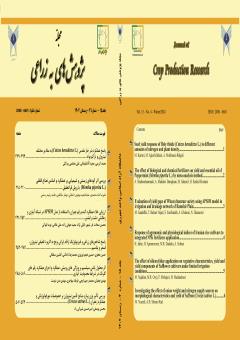پاسخ شاخصهای زراعی و فیزیولوژیک ارقام ایرانی برنج به کاربرد تلفیقی نیتروژن، فسفر و پتاسیم
محورهای موضوعی : پژوهش های به زراعی
حسن جعفری
1
,
حسین عجم نوروزی
2
*
![]() ,
محمدرضا داداشی
3
,
افشین سلطانی
4
,
محمدرضا داداشی
3
,
افشین سلطانی
4
1 - دانشجوی دکتری، گروه زراعت، واحد گرگان، دانشگاه آزاد اسلامي، گرگان، ايران
2 - دانشیار گروه زراعت، واحد گرگان، دانشگاه آزاد اسلامي، گرگان، ايران
3 - استادیار گروه زراعت، واحد گرگان، دانشگاه آزاد اسلامي، گرگان، ايران
4 - استاد گروه زراعت، دانشگاه علوم كشاورزي و منابع طبيعي گرگان، گرگان، ایران
کلید واژه: برنج, جذب NPK, شاخص خوابیدگی, عملکرد دانه,
چکیده مقاله :
این پژوهش با هدف بررسی پاسخ شاخصهای فیزیولوژیک و زراعی ارقام ایرانی برنج به کاربرد تلفیقی نیتروژن، فسفر و پتاسیم در مزرعه¬ای واقع در استان مازندران، شهرستان ساری طی سال¬های 1396 و 1397 اجرا گردید. آزمایش به صورت کرتهای خرد شده در قالب طرح پایه بلوکهای کامل تصادفی با چهار تکرار انجام شد. پنج شیوه مدیریت مصرف مقادیر مختلف کودهای شیمیایی (N250P150K150، N200P100K100، N150P75K75، N100P50K50 و N0P0K0) بهعنوان عامل اصلی و ارقام محلی برنج (سنگ طارم و طارم هاشمی) بهعنوان عامل فرعی در نظر گرفته شدند. نتایج نشان داد، بالاترین شاخص خوابیدگی میانگره¬های سوم و چهارم در تیمارهای N250P150K150 و N200P100K100 مشاهده شد. کاربرد تیمار N200P100K100 سبب افزایش تعداد پنجه بارور در کپه (25/13) و نهایتاً تولید حداکثر عملکرد دانه (4806 کیلوگرم در هکتار) گردید، اگرچه با تیمارهای N250P150K150 و N150P75K75 اختلاف آماری معنی¬داری نداشت. با افزایش سطوح مصرف کودهای NPK، غلظت NPK در دانه و کاه و هم¬چنین محتوای پروتئین دانه به طور معنی¬داری افزایش یافت. بین دو رقم مورد مطالعه اختلاف آماری معنی¬داری از نظر عملکرد دانه و غلظت نیتروژن و پتاسیم در گیاه وجود نداشت ولی غلظت فسفر در دانه برای رقم طارم هاشمی حدود 9/8 درصد بیشتر از رقم سنگ طارم بود. بنابراین، کاربرد تیمار N150P75K75 گزینه مناسب¬تری جهت بهبود عملکرد دانه ارقام برنج همراه با کاهش میزان مصرف کودهای شیمیایی و متعاقب آن کاهش هزینه¬های کودی و تبعات محیط زیستی است.
The aim of present study was to investigate the effects of NPK chemical fertilizer management on parameters related to lodging, yield components, grain yield and NPK nutrient uptake in local rice cultivars. The experiment was conducted in farms located in Mazandaran province, Sari, during 2017 and 2018. The experiment was performed as split plot in a randomized complete block design with four replications. The different doses of fertilizer treatments at five levels including F1: N250P150K150, F2: N200P100K100, F3: N150P75K75, F4: N100P50K50, and F5: Control (N0P0K0) as main plot and local rice cultivars at two levels of Sang Tarom and Tarom Hashemi were considered as sub-plots. The results showed that the highest third and fourth internodes lodging index were observed in N250P150K150 and N200P100K100 treatments. Application of N200P100K100 treatment increased the number of fertile tillers per hill (13.25) and finally produced highest grain yield (4806 kg/ha-1), although there was no significant difference with N250P150K150 and N150P75K75 treatments. When the doses of NPK fertilizers increased, the concentration of NPK in grain and straw and as well as grain protein content also enhanced. There was no statistically significant difference between the two cultivars in terms of grain yield and concentration of N and K in plant, but the concentration of P in grain for Tarom Hashemi cultivar was about 8.9% higher than Sang Tarom. According to the findings of this study, the application of N150P75K75 treatment is a better option to improving the grain yield of rice cultivars along with a decrease in chemical fertilizers and subsequent reduced fertilizers costs and environmental damages.

